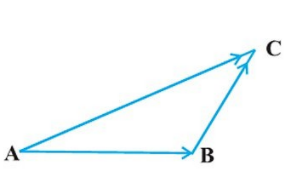If C is the mid point of AB and P is any point outside AB then (A) −−→PA+−−→PB+−−→PC=0 (B) −−→PA+−−→PB+2−−→PC=→0 (C) −−→PA+−−→PB=−−→PC (D) −−→PA+−−→PB=2−−→PC
To solve the problem, we start by defining the points and their position vectors based on the information given.
1. Define Points and Vectors:
- Let the position vector of point A be denoted as →A.
- Let the position vector of point B be denoted as →B.
- Since C is the midpoint of AB, the position vector of point C can be expressed as:
→C=→A+→B2
- Let the position vector of point P (any point outside AB) be denoted as →P.
2. Express Vectors PA, PB, and PC:
- The vector from P to A (→PA) can be expressed as:
→PA=→A−→P
- The vector from P to B (→PB) can be expressed as:
→PB=→B−→P
- The vector from P to C (→PC) can be expressed as:
→PC=→C−→P=(→A+→B2)−→P
3. Combine PA and PB:
- Now, we will add the vectors →PA and →PB:
→PA+→PB=(→A−→P)+(→B−→P)=→A+→B−2→P
4. Relate PA + PB to PC:
- From the expression for →PC, we can multiply it by 2:
2→PC=2(→A+→B2−→P)=→A+→B−2→P
- Thus, we have:
→PA+→PB=2→PC
5. Conclusion:
- Therefore, we conclude that:
→PA+→PB=2→PC
- This matches option (D) from the given choices.
Final Answer:
The correct option is (D) →PA+→PB=2→PC.
- Let the position vector of point A be denoted as →A.
- Let the position vector of point B be denoted as →B.
- Since C is the midpoint of AB, the position vector of point C can be expressed as:
→C=→A+→B2
- Let the position vector of point P (any point outside AB) be denoted as →P.
- The vector from P to A (→PA) can be expressed as:
→PA=→A−→P
- The vector from P to B (→PB) can be expressed as:
→PB=→B−→P
- The vector from P to C (→PC) can be expressed as:
→PC=→C−→P=(→A+→B2)−→P
- Now, we will add the vectors →PA and →PB:
→PA+→PB=(→A−→P)+(→B−→P)=→A+→B−2→P
- From the expression for →PC, we can multiply it by 2:
2→PC=2(→A+→B2−→P)=→A+→B−2→P
- Thus, we have:
→PA+→PB=2→PC
- Therefore, we conclude that:
→PA+→PB=2→PC
- This matches option (D) from the given choices.
The correct option is (D) →PA+→PB=2→PC.
Similar Questions
Knowledge Check
If [2→a−3→b→c→d]=λ[→a→c→d]+μ[→b→c→d], then 2λ+3μ=
A13B−5C7Dnone of theseIf →a,→b and →c are unit vectors such that→a+→b+→c=0, then the values of →a.→b+→b.→c+→c.→a is
A1B32C−32Dnone of these
Prove that →a.{(→b+→c)×(→a+2→b+3→c)}=[→a→b→c].
View SolutionIf →A+→B=→C, and ∣∣→A∣∣=2∣∣→B∣∣ and →B.→C=0, then
View SolutionIf →a+→b+→c=0 and|→a|=3,∣∣→b∣∣=5,|→c|=7, then find the value of →a⋅→b+→b⋅→c+→c⋅→a.
View SolutionIf the position vector of these points are →a−2→b+3→c,2→a+3→b−4→c,−7→b+10→c, then the three points are
View SolutionThree vector →A,→B, →C satisfy the relation →A⋅→B=0and →A.→C=0. The vector →A is parallel to
View SolutionThree vector →A,→B, →C satisfy the relation →A⋅→B=0and →A.→C=0. The vector →A is parallel to
View Solution

